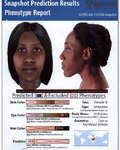

There are two sets of unidentified human remains officially in the care of the Lewis County Coroner’s Office: one was discovered on a timber property near Raubuck Road in the Winlock area roughly a month ago, while the other, found near Morton in April 2011, has been there for roughly 10 years without a positive identification
“We don’t release anybody out of here for any type of final disposition until they are positively identified,” Lewis County Coroner Warren McLeod said.
Forensic investigators have an extensive toolbox at their disposal for identifying human remains, but the biggest roadblock they face when working to identify a body or remains isn’t necessarily something science and technology can fix: to identify a body, investigators need some record of the person from before their death.
That lack of available antemortem records is what has so far prevented the Lewis County Coroner’s Office from identifying the remains found near Morton in April 2011.
A DNA analysis completed in 2018 gave investigators what they believe is an accurate depiction of the person the remains belong to — a 20- to 35-year-old woman with possible mixed ethnicity and a small stature — but investigators are still unable to definitively determine her identity.
“All of her information — DNA, everything — has been put into CODIS,” said McLeod, referring to the FBI’s DNA database. “It just appears no one has reported her missing. No one cared enough to report her missing. Which is sad. It’s absolutely sad.”
The Lewis County Sheriff’s Office, which is handling the case of the remains found near Winlock last month, are actively investigating the cause of death and the identity of the remains.
As of March 16, the remains were at the King County Medical Examiners Office being examined by a forensic anthropologist, who can determine the decedent’s age, sex, height and other physical descriptors; but no information regarding the decedent’s identity or cause of death has been released.
In most cases, when a person dies in Lewis County, there’s little to no mystery surrounding their identity. Most decedents have a family member, a neighbor or, in some cases, a police officer who knew them in life and can visually confirm their identity after death.
“The majority of our calls are in homes or with family that sees them, they sign the identification form,” McLeod said.
“If they’re facially recognizable, we can show a driver’s license photo or some government issued photo or we can do a postmortem photo, so we could take a photograph of them to show to people.”
The Lewis County Coroner’s Office even has a policy in which, if there’s no next of kin to identify a decedent, and there are booking photos or other verifiable government photographs of the person, two staff members can make the identification.
When a decedent isn’t visually identifiable, the Lewis County Coroner’s Office takes fingerprints and sends them to the FBI to run through their database, which can come back with a positive ID in less than two hours if the person has fingerprints on file.
If they don’t, or if the Coroner’s Office is unable to take fingerprints due to decomposition, then a forensic odontologist is called in to examine the decedent’s teeth and take records to compare to antemortem dental records. However, getting those dental records usually requires investigators to already have an idea of who the decedent is, or requires their pre-death dental records to have been entered into a system such as the National Crime Information Center (NCIC) or the Unidentified Persons System (NamUs). Washington state law requires the law enforcement agency handling the missing person’s case to enter the person’s antemortem dental records and other identifying information into national systems after the person has been missing for 30 days, and a dental identification can be successfully completed within a day if antemortem records are available, McLeod said.
If the decedent has an implant, such as a hip or knee replacement, the serial number from that implant can also be run through national systems and come back with a positive identification within a day.
But if the decedent hasn’t been reported missing, then it’s unlikely that their dental records or implant information will be in any national system.
Trying to identify a decedent via DNA analysis can run into a similar problem, McLeod said.
“All of that requires having an idea of who the person is and do they have anything on file prior to their death,” he said. “Other than that, we’re at a standstill.”
Due to Lewis County’s size and low transient population relative to cities such as Las Vegas and Las Angeles, McLeod said there haven’t been many cases where remains have been completely unidentifiable.
“It’s a complicated thing, but we have a lot at our disposal and forensics is always changing,” McLeod said.